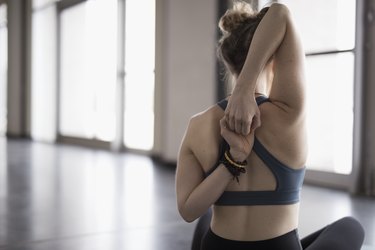
While it may be tempting to place your stretching routine on the back burner, there are multiple reasons to increase your muscle elasticity, or flexibility. Improvements in range of motion and athletic capability, stress reduction and better sleep are all benefits of a regular stretching routine.
Understanding different modes of stretching — dynamic stretching, static stretching, yoga — will help you decide how to incorporate flexibility training into your week.
Video of the Day
Video of the Day
Stretch Through the Week
Include a full-body stretching session every day says Harvard Health. Take about five to 10 minutes to complete your routine; or if that doesn't fit into your schedule, break it down into one stretch at a time throughout the day. Over time you will increase your muscular range of motion and improve elasticity. Muscles stretch better when they are warm, so it is best to do a light warmup before your routine advises the Arthritis Foundation. Walking, marching on the spot, climbing the stairs, throwing a ball with a partner or using the elliptical for five minutes are all effective ways to heat your muscles.
Read more: 6 Morning Stretches to Energize Your Day
Lengthen With Static Stretches
Muscles can become constricted, negatively affecting flexibility, appearance and capability. During static stretches, you hold your muscle in a lengthened position to increase muscle fiber length and elasticity. The stretches can help restore tight muscles and help you unwind — in fact, the muscular relaxation makes it important to do static stretches after a workout, not before.
Every time you do a static stretch, hold it until your feel slight tension, not pain, in the muscle — typically 30 seconds, says the International Association for Dance Medicine and Science. Complete four to five repetitions of a stretch. Examples of static stretches include the seated hamstrings stretch, standing hip-flexors stretch and the standing calf stretch.
Dynamically Stretch Your Muscles
Dynamic stretches use more than one muscle at a time, and focus on speed and taking the muscle through its range of motion according to the University of Virginia. These dynamic stretches improve elasticity, muscular efficiency and decrease the risk of muscular strain or exertion during exercises. Dynamic stretching should be done before a workout. For example, arm circles "wake up" your shoulders, signaling it's time to exercise. Do dynamic stretches for a total of 60 seconds, breaking it into segments appropriate to your fitness level.
Yoga and Muscle Elasticity
Yoga provides an opportunity to increase muscular elasticity while working on personal fitness, balance, stress reduction and mindfulness. In addition to improving flexibility, yoga may help alleviate symptoms of asthma, depression and anxiety. If you like group fitness, a yoga class may interest you. Consider a DVD or podcast if you prefer to exercise on your own. One bonus of going to a class is the instructor — she can correct your form and ensure that you are doing the yoga poses correctly.